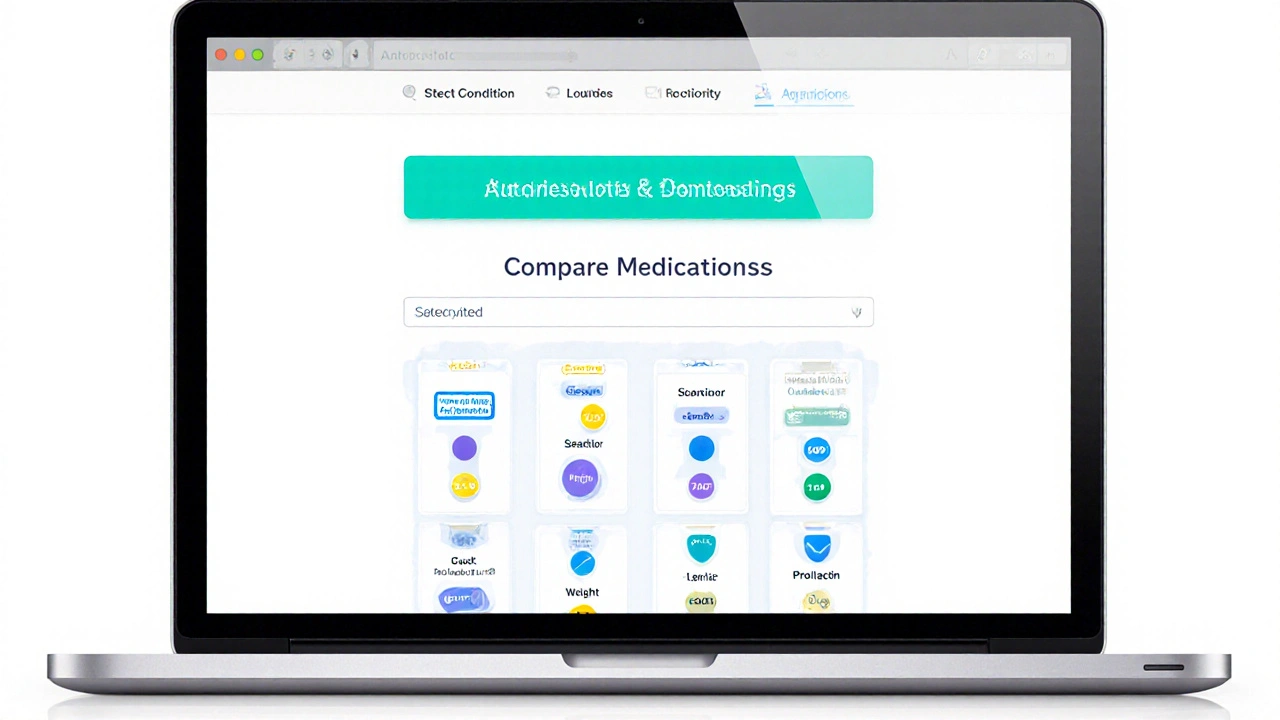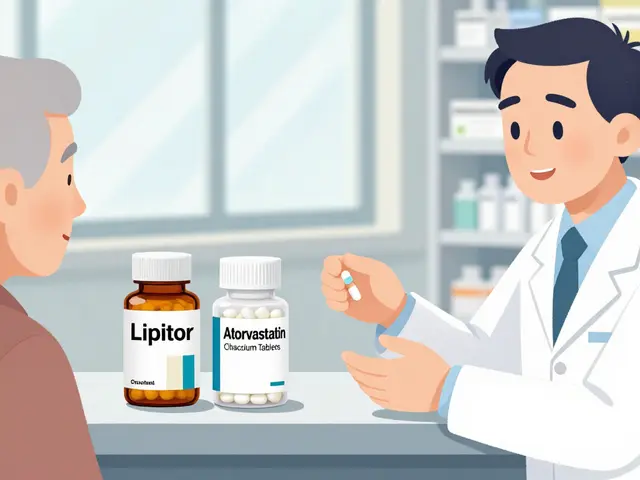Antipsychotic Medication Comparison Tool
Seroquel (Quetiapine) Overview
Uses: Schizophrenia, Bipolar I (mania & depression), Adjunct MDD
Dosage: 150-800 mg/day
Quetiapine is particularly effective for sleep-related symptoms and has broad FDA approval. It's gentler on motor side effects but less potent for acute psychosis.
Quick Take
- Quetiapine (Seroquel) is best for sleep‑related symptoms but can cause weight gain.
- Risperidone offers stronger psychosis control with higher risk of prolactin rise.
- Olanzapine is very effective for mania but has the highest metabolic impact.
- Aripiprazole is the least sedating, good for active patients, but may be less soothing for insomnia.
- Cost and insurance coverage often tip the balance more than subtle efficacy differences.
When you or a loved one is prescribed Quetiapine (Seroquel), the first question is usually: "Are there better options for my condition?" The answer depends on three things - what you’re treating, which side effects you can tolerate, and how the drug fits into your budget.
This guide breaks down the most common alternatives, measures them against real‑world criteria, and gives you a clear picture of when each drug shines or falls short.
How Quetiapine Works and When It’s Usually Chosen
Quetiapine is a second‑generation (atypical) antipsychotic that blocks dopamine D2 receptors and serotonin 5‑HT2A receptors. Its relatively low affinity for D2 means it’s gentler on motor side effects like tremor, but the same trait also makes it less potent for acute psychosis.
Clinicians love it for three reasons:
- Sleep‑inducing effect - at lower doses it acts like a sedative, helping patients with bipolar depression or schizophrenia who also struggle with insomnia.
- Broad approval - FDA cleared for schizophrenia, bipolar I (both mania and depression), and as an adjunct for major depressive disorder.
- Flexible dosing - tablets come in 25mg to 400mg, allowing slow titration.
Typical side‑effects include weight gain, dry mouth, and occasional orthostatic hypotension. Metabolic impact is moderate compared with other atypicals, but it’s still a factor to watch.
Key Criteria for Comparing Antipsychotics
Before we dive into the alternatives, here’s the checklist most patients and doctors use:
- Efficacy for core symptoms - how well it tames hallucinations, delusions, mood swings.
- Sedation level - does it make you drowsy or keep you alert?
- Metabolic profile - weight gain, blood sugar, cholesterol changes.
- Prolactin impact - risk of elevated prolactin causing menstrual issues or sexual dysfunction.
- Side‑effect tolerability - EPS (extrapyramidal symptoms), cardiac concerns, etc.
- Cost & insurance coverage - generic availability, out‑of‑pocket cost.

Comparison Table of Major Alternatives
| Drug | FDA‑Approved Uses | Typical Dose Range (mg/day) | Sedation | Weight‑Gain Risk | Prolactin Rise | Typical Cost (AU$ per month) |
|---|---|---|---|---|---|---|
| Quetiapine | Schizophrenia, Bipolar I, Adjunct MDD | 150‑800 | High (especially <200mg) | Moderate | Low | ≈$45‑$70 |
| Risperidone | Schizophrenia, Bipolar I, Irritability in ASD | 1‑8mg | Low‑moderate | Low‑moderate | High (↑ prolactin) | ≈$30‑$55 |
| Olanzapine | Schizophrenia, Bipolar I | 5‑20mg | Low | High | Low‑moderate | ≈$50‑$80 |
| Aripiprazole | Schizophrenia, Bipolar I, Adjunct MDD | 2‑30mg | Low | Low | Low | ≈$60‑$90 |
| Ziprasidone | Schizophrenia, Bipolar I | 20‑160mg (twice daily) | Low‑moderate | Low | Low‑moderate | ≈$55‑$85 |
| Lurasidone | Schizophrenia, Bipolar I depression | 20‑120mg | Low | Low‑moderate | Low | ≈$70‑$100 |
How Each Alternative Stacks Up Against Quetiapine
Risperidone is the go‑to when you need a sharp anti‑psychotic punch. It controls delusions faster than quetiapine, but the trade‑off is a noticeable rise in prolactin, which can cause menstrual irregularities or decreased libido. If you’re a young adult without a history of hormonal issues, risperidone can be a solid choice.
Olanzapine shines in acute mania and severe psychosis. In head‑to‑head trials, it reduced hospital stay lengths more than quetiapine. However, it’s also the biggest offender for weight gain and dyslipidemia. For patients already battling diabetes or obesity, olanzapine is usually a last resort.
Aripiprazole works differently - it’s a partial dopamine agonist, meaning it can stabilize mood without the heavy sedation that quetiapine provides at low doses. This makes it ideal for professionals who need to stay alert. The downside is that it can feel “activating” for some, leading to insomnia if taken later in the day.
Ziprasidone has a low metabolic footprint, comparable to aripiprazole, but requires twice‑daily dosing with food. That can be a compliance hurdle. Its cardiac QT‑interval prolongation risk demands an ECG before start, especially for patients on other QT‑prolonging meds.
Lurasidone is relatively new in the Australian market but has solid data for bipolar depression. It offers low weight‑gain risk and modest sedation. The main limitation is that it must be taken with at least 350kcal of food, which can be tricky for patients with poor appetite.
Choosing the Right Antipsychotic for Your Situation
Here’s a quick decision tree you can run through with your doctor:
- Are you mainly battling psychosis (hallucinations, delusions) or mood swings?
- If psychosis dominates, consider risperidone or olanzapine for stronger dopamine blockade.
- If mood stabilization and sleep are priorities, quetiapine’s sedating effect might be a benefit.
- Do you have pre‑existing metabolic concerns (diabetes, high cholesterol)? If yes, lean toward aripiprazole, ziprasidone, or lurasidone.
- Is prolactin‑related side‑effect a deal‑breaker? Avoid risperidone and consider quetiapine, aripiprazole, or lurasidone.
- Check your insurance formulary - generic options like quetiapine and risperidone are often cheaper.
Remember, the “best” drug isn’t a one‑size‑fits‑all label; it’s the one that aligns with your symptom profile, lifestyle, and financial picture.
Common Pitfalls and Pro Tips
- Don’t switch without tapering. Abruptly stopping quetiapine can cause rebound insomnia or agitation.
- Watch the first two weeks. Sedation, orthostatic drop, or nausea often settle after 5‑7 days.
- Monitor labs. Quarterly fasting glucose and lipid panels are recommended for most atypicals.
- Ask about drug interactions. Quetiapine and many alternatives are metabolized by CYP3A4; avoid strong inducers like rifampicin.
- Consider long‑acting injectables (LAIs) if adherence is a concern - risperidone and olanzapine have depot forms.

Frequently Asked Questions
Can I take quetiapine for anxiety?
Off‑label, low‑dose quetiapine is sometimes prescribed for generalized anxiety, but the evidence is mixed. The sedation it provides can help with sleep‑related anxiety, yet long‑term use may lead to metabolic side effects. Always discuss risks with your clinician.
Is quetiapine safer during pregnancy?
Data are limited. Animal studies haven’t shown major teratogenic effects, but human registries suggest a small increase in neonatal withdrawal symptoms. If you’re pregnant, doctors often prefer haloperidol or a low‑dose atypical with a longer safety record.
How long does it take for quetiapine to work for bipolar depression?
Patients usually notice mood improvement within 2‑4 weeks, but full therapeutic effect can take up to 8 weeks. Titrating slowly-starting at 50mg nightly and increasing every few days-helps minimize sedation.
What’s the biggest cost difference between quetiapine and aripiprazole?
In Australia, a 30‑day supply of generic quetiapine costs roughly $45‑$70, while brand‑name aripiprazole (or its generic) runs about $60‑$90. Pharmacy discount programs can narrow the gap, but quetiapine remains the cheaper option for most patients.
Can I switch from quetiapine to risperidone without a washout period?
Clinicians usually cross‑taper: reduce quetiapine by 50mg each night while introducing risperidone at 0.5‑1mg. This overlapping week helps avoid rebound psychosis or insomnia. A strict “washout” isn’t needed but supervision is essential.
Choosing between Seroquel and its alternatives isn’t a gamble-it’s a calculated decision based on symptom priorities, side‑effect tolerance, and budget. Use the comparison table, weigh the pros and cons, and have an open chat with your prescriber. The right match can mean smoother days, steadier mood, and fewer health worries.







October 3, 2025 AT 05:04
I totally get how overwhelming the choice can feel. Quetiapine’s sleep‑inducing side effect is a real boon for night‑time insomnia, especially when you’re also dealing with mood swings. At the same time, keep an eye on weight gain-it’s not as severe as with olanzapine, but it’s there. Talking to your prescriber about a gradual titration can often smooth out those side effects.